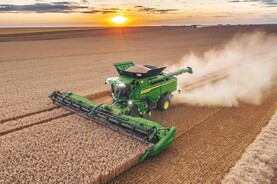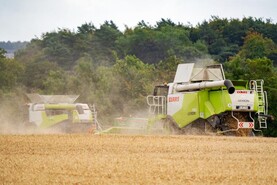Harvesters
Whenever farms are busy, safety risks escalate due to a combination of more people around, more machines working and longer working hours. There are any number of hazards. From an electrical perspective, combine harvesters and silage harvesters coming in contact with electricity wires and poles is a big risk. Always look out for overhead wires when operating tall equipment.
Grain crimpers
The processing of feed on farms is another risk. Machines such as grain crimpers and rollers all have moving parts and pose a risk. Make sure that all moving parts are protected and turn the machine off before doing any work on it.
Acid treatment and methane gas
Acid treatment of grains is another potential risk of injury as acid is toxic and can cause burns to hands and skin.
Methane gas is another risk. This is more commonly associated with slurry agitation but is also a risk with feed storage tanks and silos where methane can displace oxygen in the air and cause suffocation. Never enter feed bins or liquid feed storage tanks or other confined spaces where feed or other organic materials are stored.
The usual risks exist with handling bales and feeding out bales.
Wear sun protection
Long, hot summer days, while enjoyable, are also a high risk for sun burn and prolonged exposure to sun is a high risk factor for skin cancer. Farmers should wear caps and hats to keep the sun off their face and skin. Sun protection lotion should also be worn at all times. It’s not just to protect against sunburn. One person dies every week in Ireland from skin cancer and those working in the outdoors account for 25% of all deaths.
Dairy farm expansion
The expanding dairy sector is creating opportunities all over the place. Farmers can switch from less profitable farm enterprises to dairy. Builders, fitters and service technicians are in high demand to service the needs of the ever-growing dairy herd. There are a lot more opportunities for people to work in dairy farming, from farm assistants to owner operators. Over 6,000 new jobs are expected to be created in the dairy industry up to 2025.
However, the expansion of the sector has also created opportunity for risk. Of course, there is financial risk for every enterprise, but the risk referred to here is health and safety risk. The health and safety risk of an expanding business is much greater than that of a well-established business. This is because things change fast on an expanding farm.
Cow numbers increase and more people are employed to handle the extra numbers. These people could be in the form of sub-contractors such as farm machinery contractors, hoof-parers, relief milkers, etc, or full-time employees.
With more people around, there is a higher risk of somebody being in the wrong place at the wrong time, or incorrectly operating equipment or handling animals due to inexperience. Thus, the risk of accidents increases.
Expanding farms create risks in other areas too. As one farmer said to me recently: “When you expand you’re told about managing extra cows and how to look after your finances, but you’re rarely told that it takes twice as long to top a paddock because it’s now twice as big, or that it takes an extra two hours to feed the cows in the morning.”
Everything takes longer with extra numbers and that in itself creates a risk of fatigue and burnout.
Expanding dairy farms require more infrastructure. Building this infrastructure can be dangerous.
Slurry tanks
Sites for slurry tanks need to be excavated and building sheds involves working at heights. That’s not to mention all the various risks of trips and falls around building sites. Generally speaking, the health and safety protocols on farm building sites are not to the same standard as general building sites. This creates risk to the general public, builders and farm workers.






 This is a subscriber-only article
This is a subscriber-only article










SHARING OPTIONS: